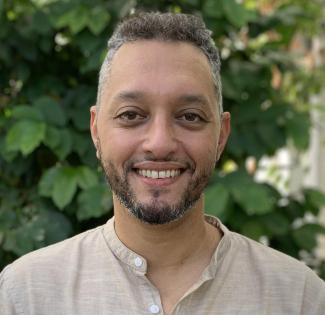"A flower blossoms for its own joy." was once stated by Oscar Wilde, but the science of biology says there's a bit more to it. In January of 2022, the Department of Biology welcomed its newest faculty member, Dr. Aman Husbands. Read below on how Dr. Husbands is studying complexity and reproducibility and asks the fascinating question: How does development create such complex and beautiful shapes, and why doesn’t it go wrong all the time?
What is your educational background?
I did my B.Sc. at the University of Toronto where I learned to love plants from Nancy Dengler. I had a chance to do paid research in her lab during the summer and that confirmed my desire to go to grad school. I did my PhD with Patricia Springer at the University of Riverside, California. This was my first chance to learn real molecular biology, biochemistry, and development, and that’s been the focus of my career ever since. My postdoc was with Marja Timmermans at Cold Spring Harbor Laboratory in Long Island, New York. There I began to use my molecular training in the context of how plants polarize their organs to create complex biological structures. Finally, I started as a faculty member in the Molecular Genetics Department at The Ohio State University in 2018 before being recruited to Penn in Jan of 2022.
Why are you excited to be part of the Department?
So many reasons! This is a strong multidisciplinary department with a lot of smart people working on a lot of interesting things. The scientific stimulation is really second to none. In particular, I’ve known members of the plant group since I was a PhD student – and now they are my colleagues, which is a real treat for me. Collaboration and communication between department members is easy and encouraged. In addition, the resources in the Department, and indeed at Penn in general, are phenomenal. Moving to Penn was a chance to ask big questions and have the resources and expertise to answer them. In short, a once-in-a-lifetime opportunity.
Tell us a bit about your research.
We’re interested in two parallel but overlapping areas: complexity and reproducibility. How does development create such complex and beautiful shapes, and why doesn’t it go wrong all the time? The first area involves the CLASS III HOMEODOMAIN LEUCINE ZIPPER (HD-ZIPIII) proteins, a family of deeply conserved transcription factors that regulate crucial developmental processes like stem cell maintenance, vasculature formation, flat leaf production, and floral development. The second area involves identifying genetic determinants of developmental reproducibility or robustness. Our system to study this broad question is the production of flat leaf architecture – something that is very hard to do yet plants have somehow figured out.
Tell us some more of the research you are doing right now inside your lab.
HD-ZIPIII transcription factors are fascinating because they operate in very different developmental processes. Determining how HD-ZIPIII proteins can function in such different developmental contexts is an important ongoing project in the lab. Possibly related to this, HD-ZIPIII proteins contain a StAR-related transfer (START) domain, in addition to their DNA-binding and dimerization domains. This raises the intriguing possibility that HD-ZIPIII activity may be under direct control of a lipophilic ligand. Identifying and characterizing these lipid signals, and how that regulation may have changed throughout plant evolution, is another ongoing project. Finally, we are tackling this big question of developmental reproducibility using techniques ranging from mathematical modeling to natural variation to quantitative trait mapping to CRISPR-mediated rewiring of gene regulatory networks.
What questions do you hope your research will help answer in the next 5-10 years?
For the complexity side, how did this important gene family change throughout plant evolution? And how did changes in its regulatory behavior track with the increasing complexity of plant forms? HD-ZIPIII transcription factors have conceptual similarities with nuclear receptors in metazoans – how deep do these similarities go? Can this explain the remarkable redeployment of HD-ZIPIII proteins into nearly all aspects of plant development? For the reproducibility side, can we engineer plants to be more resistant to climate change? One of the hallmarks of climate change is increased variability in the environment. Can we ‘biologically stabilize’ organisms in the face of increasing environmental variability? On a more basic science note, do all organisms create robust outcomes in the same way? And is it always good to be robust…?

